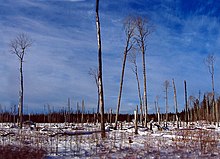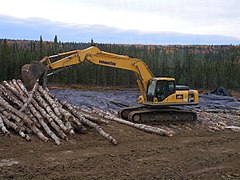Muskeg
This article needs additional citations for verification. (June 2007) |

Muskeg (
Muskeg consists of non-living organic material in various states of decomposition (as peat), ranging from fairly intact sphagnum moss, to sedge peat, to highly decomposed humus. Pieces of wood can make up five to fifteen percent of the peat soil. The water table tends to be near the surface. The sphagnum moss forming it can hold fifteen to thirty times its own weight in water, which allows the spongy wet muskeg to also form on sloping ground.
Muskeg patches are ideal habitats for beavers, pitcher plants, agaric mushrooms and a variety of other organisms.
Composition
Muskeg forms because permafrost, clay or bedrock prevents water drainage. The water from rain and snow collects, forming permanently waterlogged vegetation and stagnant pools. Muskeg is wet, acidic, and relatively infertile, which prevents large trees from growing, although stunted shore pine, cottonwood, some species of willow, and black spruce are typically found in these habitats.[2] It needs two conditions to develop: abundant rain and cool summers. A dead plant that falls on dry soil is normally attacked by bacteria and fungi and quickly rots. If the same plant lands in water or on saturated soil, it decomposes differently. Less oxygen is available under water, so aerobic bacteria and fungi fail to colonize the submerged debris effectively. In addition, cool temperatures retard bacterial and fungal growth. This causes slow decomposition, and thus the plant debris gradually accumulates to form peat and eventually muskeg. Depending on the underlying topography of the land, muskeg can reach depths greater than 30 metres (100 ft).
Description
Although, at first glance, muskeg resembles a
Surface strength

Muskeg can be a significant impediment to transportation. During the 1870s, muskeg in
Many other instances have been reported of heavy construction equipment vanishing into muskeg in the spring as the frozen muskeg beneath the vehicle thawed. Construction in muskeg-laden areas sometimes requires the complete removal of the soil and filling with gravel. If the muskeg is not completely cleared to bedrock, its high water content will cause buckling and distortion from winter freezing, much like permafrost.
One method of working atop muskeg is to place large logs on the ground, covered with a thick layer of clay or other stable material. This is commonly called a corduroy road. To increase the effectiveness of the corduroy, prevent erosion,[4] and allow removal of material with less disturbance to the muskeg, a geotextile fabric is sometimes placed down before the logs. However temporary winter access roads on muskeg (ice road), created by clearing the insulating snow and allowing the muskeg to freeze, are more commonly used as they are cheaper to construct and easier to decommission. Water is often sprayed on these roads to thicken the ice allowing heavy trucks and equipment to safely access remote sites in the winter.[citation needed]
In fiction
In Jack London's short story, "Love of Life," the starving protagonist eats muskeg berries along the trail. "A muskeg berry is a bit of seed enclosed in a bit of water. In the mouth the water melts away and the seed chews sharp and bitter. The man knew there was no nourishment in the berries, but he chewed them patiently with a hope greater than knowledge and defying experience."
In Martha Ostenso's novel Wild Geese, the land owned and beloved by the antagonist plays an important role: "Southeast, under the ridge, bottomless and foul, lay the muskeg, the sore to Caleb's eye. In the heat of summer it gave up sickly vapours in which clouds of mosquitoes rose. Cattle and horses, breaking through the pasture fence and heading for the hay field, had disappeared beneath its spongy surface." (p. 12)
In
Gallery
-
Stunted shore pine growing on muskeg in Wrangell, Alaska
-
Tracked excavator placing corduroy on muskeg near Rocky Mountain House, Alberta
-
Caterpillar D300E hauling on a corduroy road built over muskeg
Sources
- C. Michael Hogan. 2008. Black Spruce: Picea mariana, GlobalTwitcher.com, ed. Nicklas Stromberg, November, 2008
- "What on Earth is Muskeg?". Forest Facts. Tongass National Forest. 25 August 2000. Archived from the original on 14 January 2012.
References
- ^ Cree Dictionary. "Maskek". Retrieved 2009-04-15.
- ^ C. Michael Hogan. 2008
- ^ "OKthePK - Last Call". www.okthepk.ca. 2013-09-02. Retrieved 2021-09-01.
- ^ Government of Alberta: Geotechnical and Erosion Control Archived 2007-12-21 at the Wayback Machine



